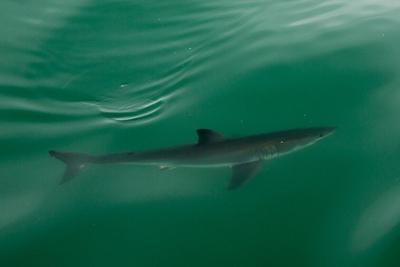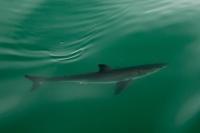Young sharks seen off Dana Point coast not a threat to people, expert says

A juvenile Great White shark made an appearance near the surface last Friday just outside the OC Dana Point Harbor. Photo by Dale Fink, Capt. Dave’s Dolphin & Whale Watching Safari
By Andrea Papagianis
While sightings of mammals like dolphin and whales outside of Dana Point’s port are common, visits from other ocean creatures near the water’s surface such as sharks are rare. But last week, whale watchers and beachgoers alike were treated to two separate viewings of the fish world’s toothy predators.
On Friday, passengers aboard a Capt. Dave’s Dolphin & Whale Watching Safari vessel got up close to a juvenile great white just outside the Harbor. The shark, measuring about 5 feet in length, was spotted about half a mile off the shore in less than 100-foot waters, said Danielle Conley with the excursion company.
Regional shark expert Chris Lowe, with the Shark Lab at California State University Long Beach, confirmed the shark’s species by its coloring, head shape and dorsal fins. Lowe said, while great whites are often confused with the mako shark, this young animal was most definitely a white.
He said it isn’t uncommon to see an influx of young sharks near the shores of known hotspots like Santa Barbara, San Diego, Dana Point and Santa Monica Bay during this time of year.
Great white birthing season starts in the spring and with no motherly direction, young sharks stick close to the shore for easy prey like halibut and sting rays, Lowe said. Young great whites pose no threat to humans, he added.
“They are actually big scardey cats,” Lowe said. “While they seem big to us, they are actually a small species. They are learning to feed and they feed off of things near the bottom that are easy to catch.”
A second sighting last Wednesday was documented by Dana Point resident, John Garbino, in a video available on YouTube that shows a beached baby salmon shark. Lowe confirmed the shark’s species, which typically live in northern waters and feed off of salmon, where they derive their name.
He said tracking salmon sharks through tagging has shown they live in the north, but travel south to give birth in warmer waters. The beaching of young salmon sharks is a phenomenon currently being studied, Lowe said, as researchers believe they beach themselves due to a brain infection, much like meningitis.
Salmon sharks are the only species known to contract such an infection, he said. It is believed sharks contract an infection during the birthing process that later attacks the nervous systems, by which the young sharks can lose their way. Although the beached shark seen last week was helped back into the water, Lowe said if ill, the infection is likely fatal.
For more on the CSULB shark lab, visit www. csulb.edu/labs/sharklab.
Unable to play video


